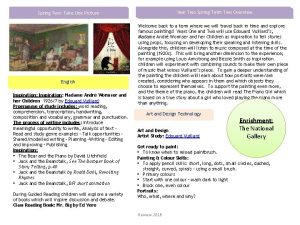Year Three Spring Term Two Overview Spring Two


- Slides: 2

Year Three Spring Term Two Overview Spring Two: Take One Picture English Inspiration: The Thames below Westminster about 1871, Claude Monet Programme of study includes: word reading, comprehension, transcription, handwriting, composition and vocabulary, grammar and punctuation. The process of writing includes: Introduce meaningful opportunity to write, Analysis of text Read and study genre examples - Talk opportunities - Shared/modelled writing – Planning –Writing - Editing and improving – Publishing Inspiration: • The Iron Man by Ted Hughes • The Sound Collector by Roger Mc Gough • Katie and the Waterlily Pond/Impressionists, by James Mayhew During Guided Reading children will explore a variety of books which will inspire discussion and debate. Class Reading Book: The Morning I Met a Whale Welcome back to a term where we will travel back in time and explore famous paintings! Years Three and Four will use Claude Monet’s, The Thames below Westminster about 1871, as inspiration to tell stories using props, focusing on developing their speaking and listening skills. Alongside this, children will listen to music composed at the time of the painting (1870 s). This will bring another dimension to the experience; for example using Gilbert and Sullivan’s operas as inspiration children will experiment with combining sounds to make their own piece of music that voices Monet’s piece. To gain a deeper understanding of the painting the children will learn about landscapes, considering what appears in them and where they are set. To support the painting even more, and theme of the river, the children will visit Teddington Lock, which is on the River Thames. Here they will learn that rivers are fundamental to how we live our lives and how they are part of the water cycle. Art and Design Enrichment: The National Gallery Computing Wild Knowledge - form • to design and create a system for collecting data Review 2016 Artist Study: Claude Monet Get ready to paint: • To apply and remove paint from brush, rinse and apply paint to the brush. Paint & Colour skills: • to experience different ways to apply watercolour, e. g. wet vs dry, wash, drip, flick. • to compare watercolour to dry pastel. • to know how much paint to apply. • to mix paint: primary colours to create secondary colours. • to apply pressure application of colour through blending. • to blend to create tone: solo colours then move onto mixing colours. Landscape: What, where, why?

Take One Picture Physical Education Netball and creative dance: • to control and coordinate their bodies and movements with increasing skill and confidence • to follow and apply more complex rules in a range of competitive and cooperative games and physical activities • to develop physical skills and techniques by observation, evaluation and refinement; and to use repetition and practice to reach higher standards • to use tactics, strategies and compositional ideas to achieve set objectives and improve performance • to recognise ways in which stamina and flexibility can be improved through daily physical activity Music Children will listen to classical music composed at the time of the painting. This will bring another dimension to the experience. Using Tchaikovsky, Valentin Zubiaurre or Gilbert and Sullivan’s operas as inspiration children will experiment with combining sounds to make their own piece of music that voices Monet’s piece or even their own artwork. Exploring sounds and performance Compose a short piece of music • to listen with attention to detail and recall sounds with increasing aural memory improvise and compose music for a range of purposes Mathematics Over the year, children will continue to develop their mathematical skills and knowledge through Maths Mastery. Alongside this, the children will apply their maths skills across the curriculum, for example in science, children will interpret and represent data using a variety of charts and then solve on and two step problems. When learning to mix primary colours, the children will start to explore ratio and proportion. In computing lessons children will learn how to collect and present data, using the information gathered from their science project about healthy eating. Social, Moral and Cultural Education – including Religious Education and RRS French Months, birthdays and colours. SMSC is embedded in what we do and who we are everyday. RRS: 38 Science Learning Objectives: (to continue from Autumn Term Two) Forces and Magnets I can compare how things move on different surfaces. I can notice that some forces need contact between two objects, but magnetic forces can act at a distance. I can observe how magnets attract or repel each other and attract some materials and not others. I can compare and group together a variety of everyday materials on the basis of whether they are attracted to a magnet, and identify some magnetic materials. I can describe magnets as having two poles. I can predict whether two magnets will attract or repel each other, depending on which poles are facing. Scientific Enquiry Skills Ask relevant questions, and use different types of scientific enquiries to answer them Set up simple practical enquiries, comparative and fair tests Make systematic and careful observations and, where appropriate, take accurate measurements using standard units, using a range of equipment including thermometers and data loggers Gather, record, classify and present data in a variety of ways to help in answering questions Record findings using simple scientific language, drawings, labelled diagrams, keys, bar charts and tables Report on findings from enquiries, including oral and written explanations, displays or presentations of results and conclusions Use results to draw simple conclusions, make predictions for new values, suggest improvements and raise further questions Identify differences, similarities or changes related to simple scientific ideas and processes Use straightforward scientific evidence to answer questions or to support their findings. Review 2016



